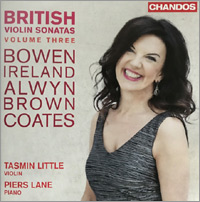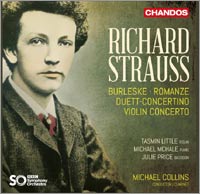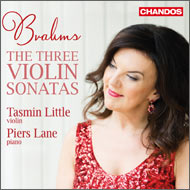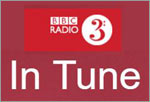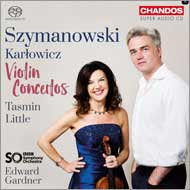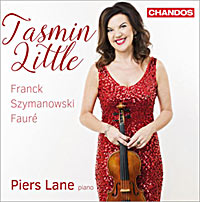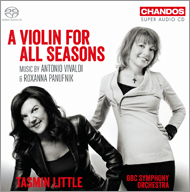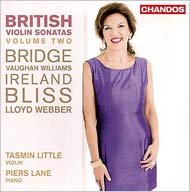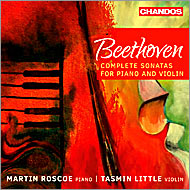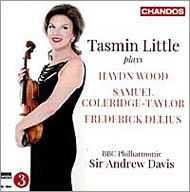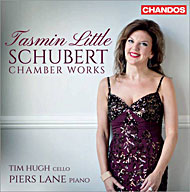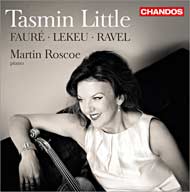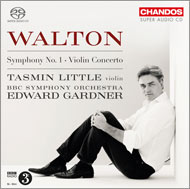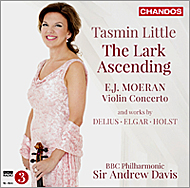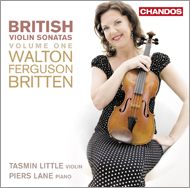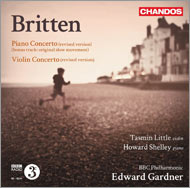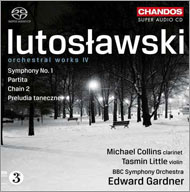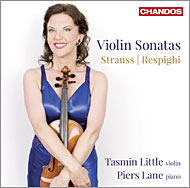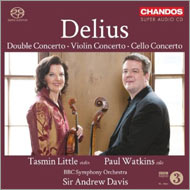
the 2021 BBC British Music Magazine Awards.
YORK BOWEN - Sonata, Op.112 (1945)
JOHN IRELAND - Sonata No.2 (1915-17)
JAMES FRANCIS BROWN - The Hart's Grace (2016)
WILLIAM ALWYN - Sonatina (1933)
ERIC COATES - First Meeting (1941, revised 1943)
CHANDOS / CHAN 20133
 Read the PDF of the CD booklet, courtesy of CHANDOS, click image.
Read the PDF of the CD booklet, courtesy of CHANDOS, click image.
| More information from | Buy the CD from: |
|---|
REVIEWS: |
|
|---|---|
GRAMOPHONE Magazine, June 2020 |
|
"... Little’s recording has an extrovert, feel-good factor, expressed in those long melodic lines she projects so instinctively, eminently supported by Lane’s robust gestures...." |
|
Jeremy Dibble |
|
BBC Music Magazine, August 2020 |
|
British Violin Sonatas Volume 3 (Tasmin Little, Piers Lane) Ireland's Second Sonata is a more troubled work, written during the First World War. Harmonically sparer than the Bowen and more jagged in its melodic contours,it receives a performance which mirrors the conviction of the composer. Even the sustained passages have an undercurrent of sorrow and regret, and the playfulness which surfaces in the finale achieves only a limited victory. As its title suggests, Alwyn's Sonatina is on a more modest scale, |
|
LIMELIGHT Magazine, July 2020 |
|
British Violin Sonatas Volume 3 (Tasmin Little, Piers Lane)
Little and Lane steer a fine series to an equally fine conclusion. by Brett Allen-Bayes on July 27, 2020 In this, the third and final instalment of an excellent series devoted to 20th-century British chamber works for violin and piano, the very fine violinist Tasmin Little has chosen to farewell with a lesser-known selection of works than in her previous instalments. Little has always been an enquiring musician who is always up for a challenge as those who have attended her local concerts will attest. Those concerts have also attested to her love of British composers. Now considering retirement from the stage, Little has chosen to consolidate that love with a triptych of fine albums featuring the sympathetic pianism of Piers Lane – and here is a true partnership, rather than violinist and accompanist, as they set out to present rarer choices for the third album in this important set of recordings. Firstly should be noted the world premiere recording of The Hart’s Grace (2016), a work of “dreamy intensity” written especially for Little by the contemporary composer, Francis Brown. Each of the three central works in this recital have had troubled histories and have remained underappreciated. Alwyn’s early Sonatina was disowned by the composer as juvenilia and yet has thankfully survived to receive this gracious performance. Similarly, York Bowen’s work remained little-known or appreciated until a couple of decades ago; and here he’s represented by his sonata, Op. 112, an intense and perhaps rather neurotic work from the 1940s. This contrasts well with Ireland’s Second Sonata, dating from the troubled 1910s. These works are ideally suited to a player of Little’s character and commitment, and Piers Lane only adds to this intoxicating and often almost febrile mix. All of these choices offer much to show the talents of these musicians, for Little is a giving player with a a passionate style and an enquiring mind; the perfect foil lies in her choice of pianist, Piers Lane and hopefully together the two of them, with this excellent recording, can re-present this overlooked music to an appreciative public. Now, can Chandos please release all three volumes as a set? |
|
THE GUARDIAN / The Observer, May 2020 |
|
British Violin Sonatas Vol 3 review – Tasmin Little bows out in style |
|
MusicWeb International, May 2020 |
|
First, the sad part; this is the last of the Little-Lane duo’s conspectus of British violin sonatas, given the violinist’s imminent retirement. But now for the good news; at least they have finally recorded John Ireland’s Violin Sonata No.2 and it’s a real scorcher of a reading. But first, a brief recap. The opening volume in the series focused on Walton, Ferguson and Britten and the second on Bridge, Bliss and Ireland (Sonata No.1). Little has always resisted pressures to record works from her repertoire when circumstances have not been right – such as orchestras or conductors, for instance. But with Piers Lane, there is no such impediment and this duo has emulated and indeed surpassed in longevity that of another similar Anglo-Australian partnership, their great predecessors Albert Sammons and William Murdoch. |
|
Phantasy Concerto, Op.63 (1946-48, revised 1958)
for Violin and Orchestra
Symphony No.2, Op.62 (1942-45)
Solo: Tasmin Little violin
Orchestra: Melbourne Symphony Orchestra
Dale Barltrop • Sophie Rowell concertmasters
Conductor: Sir Andrew Davis
CHAN 5193
 Read the PDF of the CD booklet, courtesy of CHANDOS, click image.
Read the PDF of the CD booklet, courtesy of CHANDOS, click image.
| More information from | Buy the CD from: |
|---|
REVIEWS: |
|
|---|---|
The Strad Issue: March 2020 |
|
Like Britten and Shostakovich before him, Eugene Goossens sets up a tension in his four-movement, symphonic Violin Concerto of 1948 that is only resolved at length by the finale. Walton’s Concerto of 1939 is the obvious point of contact, however, not only for the bittersweet orchestral harmony but also the glinting brilliance of its solo part, devised with Heifetz in mind, and now revived with all the requisite passion and assurance by Tasmin Little. Goossens was not the first composer to find his efforts snubbed by Heifetz, however, and the concerto had to wait until 1959 for a radio broadcast premiere, followed by a live performance directed by the composer at the BBC Proms in 1960. A record of the occasion has surfaced on YouTube, and for all the old-school projection and cantabile phrasing of soloist Tessa Robbins, it can’t rival the urgency of Little’s opening statement, her spiccato passagework like shards of flying steel in the Scherzo or the stillness and Holstian desolation cultivated by both Little and Davis in the concise slow movement. Amid a shoal of so-called underrated English orchestral works of the last century, Goossens’s concerto is a big fish. I can’t imagine it done better. The Second Symphony shares the concerto’s nervous, post-war intensity and Bartókian orchestration as well as its questing nature and conviction that old bottles may still hold a fine new vintage. The symphony would bring down the house at the Proms, especially directed by Davis, who knows the idiom inside out and secures a nimble, dynamic response from his Melbourne orchestra, recorded with ample depth and space in the concert hall at Monash University. Outstanding all round. PETER QUANTRILL |
|
BURLESKE, TrV 145 (1885-86)
in D minor for Piano and Orchestra
ROMANZE, TrV 80 (1879)
in E flat major for Clarinet and Orchestra
DUETT-CONCERTINO, TrV 293 (1947)
for Clarinet and Bassoon with String Orchestra and Harp
VIOLIN CONCERTO, TrV 110 (1881-82)
in D minor for Violin and Orchestra
Solo bassoon - Julie Price
Solo violin - Tasmin Little
Solo piano - Michael McHale
BBC Symphony Orchestra
Conductor: Michael Collins / clarinet
CHAN 20034
 Read the PDF of the CD booklet, courtesy of CHANDOS, click image.
Read the PDF of the CD booklet, courtesy of CHANDOS, click image. REVIEWS: |
|
|---|---|
The Strad Issue: July 2019 |
|
Tasmin Little (violin)1 Michael McHale (piano)2 Julie Price (bassoon) STRAUSS Violin Concerto in D minor1, Burleske2, Duett-Concertino3, Romanze4 CHANDOS CHAN 20034 With this new account appearing hot on the heels of Arabella Steinbacher’s recording (reviewed February 2019), Strauss’s Cinderella of a violin concerto seems to be winning new admirers among players. Tasmin Little brings her sweet tone and emotional commitment to this early work in an account that plays on the music’s charm and fleet-footedness. There’s a Mendelssohnian lightness, especially in the finale, that feels wholly appropriate, yet also a warmth to the first movement’s second theme and to the pensive central Lento. Just occasionally, Little’s generous vibrato on long, held notes tends towards the queasy, but her variety and richness of colouration, and her tonal flexibility across changing moods, prove to be ample compensation. The slightly boomy acoustic of LSO St Luke’s muddies the orchestral accompaniment to a certain extent, an issue that also affects the concertante works here for piano (the Burleske, where the crucial timpani lack crispness) and solo clarinet (the 15-year-old Strauss’s Romanze). But the Duett-Concertino, recorded on a later date at the BBC’s Maida Vale studios, fares better in terms of sound, and the strings of the BBC Symphony Orchestra provide silken and lush support for conductor/clarinettist Michael Collins and bassoonist Julie Price. MATTHEW RYE
|
|
Tasmin Little, violin
John Lenehan, piano
AMY MARCY CHENEY BEACH
Sonata, Op.34 (1896)
CLARA SCHUMANN
Drei Romanzen, Op.22 (1853)
DAME ETHEL SMYTH
Sonata, Op.7 (c.1887)
AMY MARCY CHENEY BEACH
Romance, Op.23 (1893)
Invocation, Op.55 (1904)
CHAN 20030
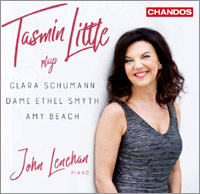 Read the PDF of the CD booklet, courtesy of CHANDOS, click image.
Read the PDF of the CD booklet, courtesy of CHANDOS, click image. REVIEWS: |
|
|---|---|
LIMELIGHT MAGAZINE - May 2019 |
|
BEACH • SMYTH • CLARA SCHUMANN (TASMIN LITTLE, JOHN LENEHAN) by Steve Moffatt on May 20, 2019 There seems to be a similar boon with the recent prominence of the gender equality debate – why it is still a ‘debate’ and not a fact remains a moot point – and women composers whose works were often admired by the musical giants of their time are slowly emerging from the gloom of neglect into some well-deserved sunlight. English violinist Tasmin Little features three women composers on her latest disc for the prestige British Chandos label, accompanied by versatile UK pianist John Lenehan. Clara Schumann’s Three Romances for violin and piano are well known and have appeared on several recordings. Dedicated to Joseph Joachim, they were written in the summer of 1853 when she and Robert moved into a house in Dusseldorf, which allowed her enough space to compose without disturbing her husband. American composer and pianist Amy Marcy Cheney Beach (1867-1944) is perhaps the star of this album. Many consider her America’s best female composer and her Sonata for Violin and Piano turns up on a dozen or so recordings over the years, while that of Dame Ethel Smyth (1858-1944) – a campaigner for women’s suffrage who was championed by Clara Schumann and admired by Brahms, Grieg and Tchaikovsky among others, and who wrote literature when she became too deaf to compose – only appears on two recordings that I could find. Smyth studied in Leipzig and her String Quartet and this Sonata, dedicated to Mendelssohn’s daughter Lili Wach, were both performed at the Gewandhaus. Coincidentally both sonatas are in A Minor and both are influenced by Brahms and Robert Schumann, but retain a strong individual voice. Beach’s talent for soaring lyricism is exploited not only in the sonata but also in two exquisite miniatures which close the disc – the Romance, Op 23, and Invocation, Op 55. Little’s touch is warm and faultless throughout this lovely program and there is a strong chemistry between her and Lenehan. Both Beach and Smyth composed large-scale works – including symphonies and operas – and after hearing this disc many listeners will want to explore their lives and music further. All credit to Little and Chandos for shining more sunlight on them.\ |
|
CLASSICAL SOURCE.com - March 2019 |
|
Tasmin Little & John Lenehan – Music by Amy Beach, Clara Schumann and Ethel Smyth for violin and piano [Chandos] by Tully Potter |
|
Although the sole reason for this programme appears to be that all the composers were women, the Sonatas by Mrs H. H. A. Beach (strangely called here “Amy Marcy Cheney Beach”, of which more anon) and the young Ethel Smyth do go well together. They are both richly romantic works but for some reason neither has come my way before, although I have admired both of these redoubtable women for many years and have acquired records of other works by them. The recording team is virtually the same as the group who made Jennifer Pike’s Polish disc at the same venue two months later, but there is no sign of the imbalance between the instruments which marred that enterprise. Tasmin Little is well recorded and so is John Lenehan, who as always proves a strong yet tactful partner. He is nicely portrayed on the back cover of the booklet but has his name in smaller type on the front cover. I do wish record companies would not do this – the players in duo-Sonatas are equals. |
|
GRAMOPHONE MAGAZINE - February 2019 |
|
Tasmin Little plays C Schumann, Beach and Smyth For a neglected Romantic violin sonata, being recorded by Tasmin Little and John Lenehan must feel like going to heaven. Neither the 1897 sonata by Amy Beach nor its slightly earlier counterpart by Ethel Smyth is new to the catalogue, but neither, surely, has ever been treated to anything like Little’s gleaming, endlessly fluid tone or John Lenehan’s warmly characterised, unfailingly sensitive pianism. The Beach comes first, and although Chandos have already served it well with an expansive account from Gabrielle Lester (1/04), there’s a flexibility and sense of sweep to Little and Lenehan’s performance that’s utterly persuasive on its own terms: meltingly tender as the pair ease into the first movement’s second group, and dark and questioning in the con dolore slow movement. The two players respond to each other as if by instinct, giving a playful glint to the outer sections of the Scherzo (Little wears her virtuosity with delicious insouciance) and emerging from the storms of the finale with terrific sweep. That’s the most thrilling moment in Ethel Smyth’s Sonata too. As with the Beach, Little and Lenehan let the four movements follow their own, cumulative course from lyrical opening to tempestuous finale, without ignoring the many pleasures to be found along the way – like the little folksy interludes that punctuate the melancholy lilt of Smyth’s slow movement. Perhaps Clara Schumann’s Drei Romanzen could have felt a little more inward – these readings are nothing if not upfront – but it’s hard to object to this kind of assurance coupled to such a fabulous sound, and in Beach’s Op 23 Romance, the pair trace the journey from intimate confession to high-romantic ardour with poetry and utter conviction. A wonderful performance. |
|
Richard Bratby |
|
THE ARTS FUSE - February 2019 |
|
You can hardly ask for more from violinist Tasmin Little’s new recording of neglected violin-and-piano pieces by mid- and late-Romantic women composers. From the technical angle, all is superb: Little’s phrasings are smart, her intonation perfect, and her shaping of the music’s dynamics and articulations consistent. Expressively, she clearly loves these pieces, playing them each with warmth and soul. It’s hard to imagine, for instance, a more fervent account of Amy Beach’s brilliant Violin Sonata in A minor than the one Little and pianist John Lenhan turn in here. This 1896 score, which followed on the heels of Beach’s exhilarating Gaelic Symphony, channels some of Brahms’ and Dvorak’s rhythmic games, but it’s steeped in Beach’s singular lyrical style, the big outer movements framing a droll, hiccupping scherzo and a soaring, intense slow movement. In Little’s hands, the incisive violin writing really catches fire, while the introspective moments (like the first movement’s second theme) simply float. A similar sensitivity to expressive nuance marks her readings of Beach’s Romance and Invocation. Little and Lenehan make correspondingly fresh work of Clara Schumann’s Three Romances. Written for Joseph Joachim in 1853, they are, like Clara’s songs, mellifluous and, for the pianist especially, involved. Here, the duo delivers a burnished account of the first Romance, gamely dances through the shadows of the second, and make sweetly wistful work of the last. Filling out the Chandos album is a lively rendition of Ethyl Smyth’s Violin Sonata in A minor. This is a Sonata that’s more clearly indebted to Brahms than Beach’s; one never quite escapes the influential shadow of the older composer. Still, the current performance is first-rate, with the mystery of the first movement’s opening theme coming across compellingly; the scherzo’s charm fully intact; a darkly lilting account of the slow movement speaking powerfully; and the finale’s stormy last bars boiling over. Ensemble-wise, Little and Lenehan prove an ideally-matched pair. The keyboard writing in each piece is highly involved – often soloistic, in fact – and Lenehan’s execution of it all is particularly fine: clean, well-balanced, and thoughtfully shaped. But he gracefully cedes the spotlight to Little and the two respond to one another’s playing with such sympathetic energy that these performances really take off. A terrific disc for the New Year, then: a couple of top-flight artists providing the just the type of advocacy one might desire for this unjustly maligned fare. |
|
Jonathan Blumhofer |
|
LEBRECHT LISTENS | Tasmin Little Reminds Us Just How Much We'll Miss Her �� Spotify | iTunes | Amazon A letter from the English violinist Tasmin Little telling me she is giving up the circuit in a couple of years when she hits 55 arrives pretty much at the same time of her latest release on Chandos, itself a fairly regular occurrence in recent years. Tasmin Little is a prolific recording artist and her programs often take a few strides off the beaten track. The latest consists of music by women — Amy Beach, Ethel Smyth and Clara Schumann — and the sense of an ending adds poignancy to its reception. Neither of the first two composers can claim that their careers were wrecked by prejudice. Both Beach and Smyth came from wealthy, well-connected families. Smyth was promoted by Sir Thomas Beecham and Beach had several dates with the Boston Symphony. What their music wears is a sense of trying a bit too hard. Tasmin Little’s natural muscularity reduces the effortful aspect to something like normality. I found the pair of sonatas — both in A minor — warmly engaging as musical conversation, with John Lenehan sounding utterly empathetic at the piano. The centrepiece of the release is Clara Schumann’s Three Romances, written in the season she met Brahms and dedicated to Joseph Joachim, who introduced the couple. Something like love is in the air and the music can all too easily be over-romanticized. This duo gets it just right for my taste, a shimmer of discovery and excitement without gestural commentary. It shows just how much we’ll miss Tasmin once she has hung up her bow. |
|
REVIEWS: |
|---|
.BBC Music Magazine. June 2018 |
....Rarely have I heard such unanimity of ensemble on disc Tasmin Little and Piers Lane's fluid yet flexible approach to rubato and tempo fluctuation can only have been achieved after years of rehearsing together and exchanging musical ideas. Little’s intense and warm vibrato is matched by Lane’s wonderfully rich piano with its emphasis on the bass register, ideally suited to Brahms..... |
Eric Levi |
THE STRAD - May 2018 |
Tasmin Little begins Brahms’s First Violin Sonata with the mixture of precision, tonal warmth and flexibility that is always a feature of her playing. She will nail one phrase with silvery brilliance and bring gentle mystery to the next. The dolce lead, back to the recapitulation of the first movement, is magical. She plays the theme of the second movement with a richness that brings her mentor Menuhin to mind. The final Allegro combines beguiling simplicity and a sense of confidentiality with a confident reprise of the slow movement at its heart. The Second Sonata has an air of reverie to it, with liquid phrasing in the first and last movements, as if she is exploring every phrase to find out what comes at the end. The vivace sections of the second movement are quicksilver, with light and nimble playing from Little and the always-excellent Piers Lane. In the first movement of the Third Sonata there are stirring, heroic moments, but here, as in all the sonatas, much of it has a feeling of intimacy, of something personal being shared. The slow movement is a seamless flow of intense, controlled emotion, and the finale has some splendid theatrical outbursts. The recorded sound is rich, with the musicians close. |
Tim Homfrey |
Gramophone magazine – April 2018 |
“… Little relishes the many instances of Brahm’s writing in the violin’s alto register and Lane is always responsive to the violin’s colourings and shadings, fining his sound right down whenever needed…” |
Harriet Smith |
ClassicalSource.com – March 2018 |
“… these are lively, alive, impassioned and searching account … At no point during this recital does one suspect these artists being fazed by the red light being on, a marriage of keen preparation and concert-hall spontaneity.” **** |
Colin Anderson |
BBC Symphony Orchestra
Edward Gardner, conductor
Tasmin Little, violin
CHAN 5185
| More information from | Buy the CD from: |
|---|
REVIEWS: |
|---|
from: THE STRAITS TIMES - Singapore January 2018 | ***** (5 Stars ) |
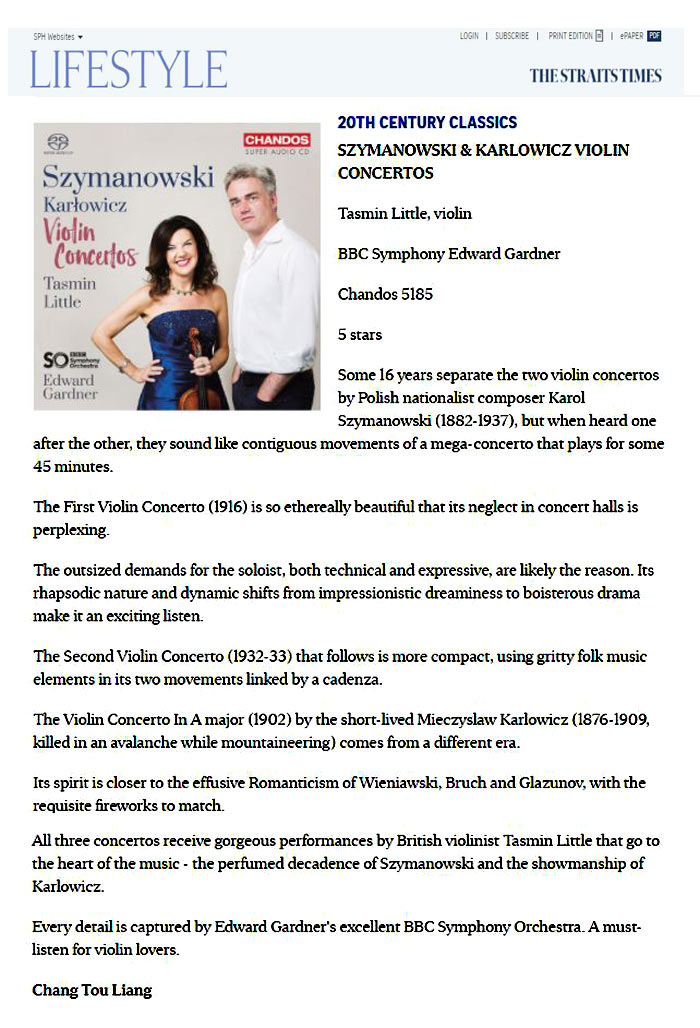 |
from: LIMELIGHT - Australian Music Magazine November 2017 | Limelight's Recording of the Month in November |
Violin Concertos It’s only recently that Tasmin Little released her recording of Karol Szymanowski’s Violin Sonata on the Chandos label, and she must have a liking for the composer as she’s followed it up with readings of both concertos by the Polish master. There’s much to be found in Szymanowski’s music, which draws on various early-20th-century influences. His Violin Concerto No 1 is considered by many to be the first modern violin concerto, and it’s a true stylistic melange: a heady concoction of impressionist colours, expressionist drama, and the sweeping lyricism of late romanticism (basically, what would become the stock template for the Hollywood soundtrack within a few decades). There’s so much detail in the vibrant orchestration, it’s easy to get swept up in the BBC Symphony Orchestra’s vivid and immersive performance under the direction of Edward Gardner. It’s a truly brilliant score, and so temperamental: rich romanticism one moment, playful and mercurial the next. Little’s performance is luscious and nuanced – broad and lyrical at moments of high drama, as well as spirited and finely articulated in faster passages. The cadenza here is a truly captivating moment. The Second Violin Concerto marks a complete change. Its language is more akin to folksong, particularly in the second movement. Szymanowski wrote the work in the summer of 1932 while on retreat in the Tatra Mountains and the region’s band music made an impression on the scoring and thematic material of the concerto. While it might not have the same level of mystery and drama as the First, the Second Concerto does pack a punch. Again, Little’s touch is deft, scaling the heights of this music with expert control and achieving a really infectious energy in the finale. The final work here is the somewhat more traditional Violin Concerto of Mieczysław Karłowicz. The work is the oldest on the disc (1902), and it’s steeped in the late Romantic tradition. The first movement is dark and brooding, while the second movement is a lush romance in sweet F Major. Little’s playing here is impassioned, moving with the drama of the music, and is particularly en pointe in the final movement, which has a kind of balletic bounce to it. This disc will be a nice addition for Tasmin Little fans, as well as a great find for violin concerto enthusiasts looking to get outside the box of well-worn favourites. Tasmin Little's Szymanowski and Karłowicz album is Limelight's Recording of the Month in November. |
from: Musical Opinion Quarterly December 2017 | ***** ( 5 Stars) |
Szymanowski: Violin Concerto No 1, Op 35; Violin Concerto No 2, Op 61; Karlowicz: Violin Concerto in A major, Op 8 Chandos's Polska Music Programme has given us a number of distinguished discs of a relatively wide range of music, but none more impressive than this, which first of all reinforces Szymanowski’s claim to be Poland's greatest composer after Chopin and then introduces us to the music of Mieczyslaw Karlowicz (1876-1909), just six years the senior of Szymanowski (1882-1937), whose brief life demonstrated a compositional gift in no way technically or expressively inferior to that of his junior colleague Adrian Thomas's excellent accompanying notes point out that Karlowicz’s Concerto (1902) owes a little to Tchaikovsky's, as - perhaps - one might expect it to, but there is much here whichbetokens a strikingly original voice, and the two more familiar Concertos by Szymanowski, if occupying a higher degree of creative originality and accomplishment, as well as Karlowicz’s earlier work, are given performances of exceptional artistry; here, Tasmin Little displays a musicianship that consistently marks her out as fully the equal, and in many respects the superior, of any violinist currently before the public. ln this regard, she is splendidly supported by the BBC Symphony under Edward Gardner, whose whole-hearted contribution to the profound impact of these performances cannot be overstated. A terrific disc, of high distinction. Robert Matthew-Walker |
from: Classical Ear |
Szymanowski: Violin Concerto No 1, Op 35; Violin Concerto No 2, Op 61; Karlowicz: Violin Concerto in A major, Op 8 Ardent support from the BBC Symphony Orchestra under Edward Gardner perfectly frames Tasmin Little's exquisitely manicured lyricism and joyful flights of fancy in the exuberantly realised finale of Karlowicz's concerto. Here’s a value-for-money coupling of three contrasting Polish violin concertos from the first half of the last century in the estimable hands of Tasmin Little. With its unabashed debt to Tchaikovsky and late-Romantic effusiveness, the earliest, Mieczysław Karlowicz’s from 1902, is a gift to Little. Ardent support from the BBC Symphony Orchestra under Edward Gardner perfectly frames her exquisitely manicured lyricism and joyful flights of fancy in the exuberantly realised finale. She’s even more striking in the two Szymanowski concertos, conjuring the heady otherness and noticeably neurotic qualities of the First (1916) with elegantly elasticated playing marked by plentiful but judiciously executed vibrato and telling shifts in dynamics. No less characterful is her sweetening of the darker, denser textures of the Second (1933) and her nimbly poised, delicately nuanced way with melodies that smack of rough-hewn rusticity before fracturing into moments of crepuscular introspection. The SACD recording lends Chandos’s customarily excellent sound a vivid immediacy. Michael Quinn - 11 October 2017 |
from: GRAMOPHONE Magazine October 2017 |
Three violin concertos – all Polish but all very different in mood – make up this latest release from Tasmin Little. programmed last on the disc, but composed first, is the concerto by Mieczyslaw Karlowicz, a big, romantic concerto very much in the mould of Tchaikovsky. The opening horn motif even echoes that of Tchaikovsky’s First Piano Concerto, albeit in reverse. Little has recorded the Karlowicz before (wonderfully) in 2003 as part of Hyperion’s Romantic Violin Concerto series. Her playing is just as strong here, with meaty staccato double-stopped passages, but it’s not all show; she is sensitive to dynamics too. Nigel Kennedy is more self-indulgent in his recording, although the earthiness and drama he brings to it is compelling. Tasmin Little trills exquisitely in the stratosphere to close the second movement, while the finale dances joyously. The BBC Symphony Orchestra, under the astute direction of Edward Gardner, offer keen support, particularly some lovely woodwind flecks of colour to the yearning Romanza slow movement. Chandos’s recording, in a reverberant acoustic, is much beefier than Hyperion’s, which is not always an advantage in orchestral climaxes. Karlowicz died young, caught in an avalanche in the Tatra Mountains in 1909, the same mountains where Karol Szymanowski and his muse, the Polish violinist Pawel Kochariski, spent the summer in 1932. It was there that Szymanowski sketched the initial ideas for his Second Violin Concerto. I heard Little and Gardner make a great case for this work at the Barbican earlier this year, presumably at the time of the Chandos recording sessions. Little really digs into the folk-like first movement, almost Bartékian in its fiddles and drones, with its fierce double- stopping and muscular cadenza — written by Kochariski - coming off splendidly. Kochariski had also been the inspiration for the First, highly perfumed and exotic in feel, composed at a time when Szymanowski was heavily influenced by Arabic culture. Little’s lustrous tone and ethereal top notes are bathed in an orchestral accompaniment that glitters and glistens, while there is fire and ice in the brief cadenza that opens the final section of the work. Her Szymanowksi is as fine as Thomas Zehetmair’s, long the benchmark recording of these two concertos; but, with the Karlowicz thrown in, this makes a highly recommendable altemative. Mark Pullinger ... |
from: BBC MUSIC MAGAZINE |
... in the 1st concerto… .she enters the music’s seductive web especially from the arrival of the slowlyrocking harmonies, one of the work's most magical moments. The Concerto No.2, a late work which shows the composer abandoning such overt hedonism for the pantheistic call of the mountains, has a more unbridled dirctness, which Little seizes gratefully. The Karlowicz though not a masterpiece to match the contemporaneous Sibelius and Elgar concertos, nor indeed on the level of the composer himself achieved little later in his career cut tragically short by a Tatra avalanche. is nevertheless invigorating in such a fine performance as this. John Allison |
PERFORMANCE: **** (4 Stars) | RECORDING: ***** (5 Stars) |
CÉSAR FRANCK - Sonata, M 8 (1886)
GABRIEL FAURE - Romance, Op.28 (1877)
KAROL SZYMANOWSKI - Sonata, Op.9 (1904)
CHAN 10940
REVIEWS |
|||
|---|---|---|---|
from: LIMELIGHT Magazine July 2017 - **** ½ Stars |
|||
Believing in being Franck: A Polish detour adds spice to Little and Lane’s French day out. |
|||
In their most recent recorded collaboration, Tasmin Little and Piers Lane deliver some of the finest French examples from the violin and piano repertoire, with a French-inspired Pole thrown in for good measure. César Franck’s Violin Sonata is a mainstay of the repertoire, exhibiting the composer’s preference for cyclic form – the use of thematic material across all movements. What’s special about the Sonata is that Franck’s compositional technicalities never eclipse the music’s dramatic and communicative nature. Little’s rendering of the opening Allegretto is perfection, with gorgeously light and silky bow strokes balanced with a more robust, powerful tone as the music approaches its climactic goals. Lane’s touch is sensitive, and matches Little’s colour range perfectly. The pair lets loose in the second and final movements, but Little’s recitativo in the third movement makes for a real moment of focus in the performance, and is probably the highlight. The Romance in B Flat by Gabriel Fauré is a beautiful divertissement in this recording. Little conjures the most stunning of reveries with this lyrical gem, offering a limpid tone that invokes a soothing calm, even during the more technically fraught passages. Lane’s playing is similarly crystal clear, and beautifully tender. Szymanowski appears to be getting more airtime these days, and thank goodness, because the Polish composer’s music does deserve more hearings. Szymanowski, like Franck, was a fantastic craftsman with a keen ear for the dramatic. His Violin Sonata is a heavier work than Franck’s, with its two outer movements calling for rich, muscular tone production in the violin part, which Little delivers. The middle movement is a serene, gentle, dreamy Andantino tranquillo e dolce, the opening of which is one of the highlights of Little and Lane’s performance. The Sonata is followed by two more works by Szymanowski. The first is a Romance that’s imbued with a rich lyricism, and which works towards a magnificent climax. But the best is saved for last, with a Notturno and Tarantella, music of 1915 and a more mature Szymanowski. The strange, exotic music of the Notturno, with its silky melodies and harmonies on open fifths, is a real treat, and the bustling Tarantella, a fantastic showstopper. |
|||
|
|||
from: STRAD Magazine June 2017 - The Strad recommends : * Star |
|||
Tasmin Little plays Franck, Szymanowski, and Fauré A powerful, strongly performed recital from an outstanding duo To sound its finest, Franck’s chromatically charged, sensually alluring Sonata requires playing of devoted intensity, and that is precisely what it receives from Tasmin Little and Piers Lane. Throughout the languorous opening allegretto, they entwine their phrases with a pulsating seductiveness that is shattered by the second movement’s explosive, hurtling momentum. Here, Lane’s fearless and headlong negotiation of Franck’s notoriously tricky writing allows Little to soar aloft with captivating emotional abandon. Rarely has the explosion of A major radiance that crowns the finale been sounded with such life-affirming incandescence. Fauré’s Romance, which tantalises with its noble restraint, forms the interlude before Szymanowski’s distinctive brand of intoxicating exoticism takes hold. The Franck-inspired Sonata shows the 22-year-old composer flexing his creative muscles with gleeful exuberance, and here Little and Lane hurl themselves into the fray with carefree delight, achieving a beguiling frisson seldom captured under studio conditions. By 1910 (when the op.23 Romance was composed) Szymanowski had developed into an Scriabinesque expressionist with a penchant for ecstatic melody, a tendency developed still further in the Notturno e Tarantella, which rethinks the Sarasate–de Falla prototype with a Debussy-like flair. It receives another gripping performance from this outstanding duo, captured in luxuriant sound of bracing physical projection. |
|||
|
|||
from: GRAMOPHONE Magazine May 2017 |
|||
Tasmin Little plays Franck, Szymanowski, and Fauré |
|||
|
|||
from:THE OBSERVER, April 23rd 2017 |
|||
Franck, Szymanowski, Fauré CD review – performances to savour - 4/5 Stars |
|||
Fiona Maddox |
|||
from: Classical Ear |
|||
Such dazzlingly assured, unflinchingly communicative music-making, this, vividly captured by the microphones. |
|||
César Franck's adorable Violin Sonata comes up as fresh as new paint in this urgently expressive and memorably flexible performance by Tasmin Little and Piers Lane. It's the opening item on their latest disc for Chandos and is followed by a no less sympathetic rendering of Gabriel Fauré's Romance in B flat major, a charming morsel completed in 1877. The rest of the programme is given over to three works by Karol Szymanowski (1882-1937), the most ambitious of which comprises the early (1904) D minor Violin Sonata, a big-hearted creation, like the Franck cyclical in form, and boasting an especially endearing, gorgeously songful slow movement with a deliciously playful pizzicato interlude at its heart. The soaringly lyrical Romance (1910) evinces a strong kinship with the composer's Second Symphony from the previous year, while the Notturno e Tarantella (1917) serves up an intoxicating feast of heady voluptuousness and headlong virtuosity. Such dazzlingly assured, unflinchingly communicative music-making, this, vividly captured by the microphones. Excellent news, too, that Little has already set down both of Szymanowski's glorious violin concertos with Ed Gardner and the BBC Symphony Orchestra – a mouthwatering prospect! |
|||
Andrew Achenbach |
|||
| More information from | Buy the CD from: |
|---|
REVIEWS |
|---|
from: MUSIC WEB INTERNATIONAL - January 2017 |
Whether this is now eight seasons or two times four makes little difference, though it adds a contemporary gloss to the programming and allows Little to add another premiere recording to her discography. She directs the BBC Symphony in a modern instrument performance that marries sufficient rhythmic resilience to sonic colour without compromising on individuality. One point struck me as curious, though it will only be of interest to violin fanciers. The orchestra is not led by Stephen Bryant but by Bradley Creswick so it’s the latter we hear jousting with Little in the Vivaldi not the expected Bryant. I wonder why? Some of the rubati in Spring are worthy of note – the chirping and deft dynamics too. Whilst the slow movement is nicely communicative the dog barks are a touch tame, or maybe I have become accustomed to less domestic canines in this movement over the years. What’s certainly true is that the full string body sounds ripely engaging. Little’s fastest-bow-in the-West approach to the opening of Summer is the acme of glamorous engagement – but she’s not afraid to generate some resinous sounds – and there’s languor and indeed torpor in the central panel of the concerto. The finale is exciting, the harpsichord audible but not over-prominent. Little’s rich tone is heard to great advantage in the opening of Autumn where there is a long harpsichord interpolation from David Wright; on repeated listening I’m not sold on it. The pizzicati in the Largo of Winter are, mercifully, not too loud – I’ve heard them obliterate the solo violin line before now – and Little decorates the line early rather than embellishing in the reprise of theme. I prefer the unembellished lyricism and affectionate directness of the classic Alan Loveday but appreciate that decoration can be appropriate and effective. It’s just that I’d have preferred it later. So, all in all, this is a rhythmically vital, colourful, engaging big band performance with a full complement of satisfying details. Panufnik’s own Seasons visits four distinct countries. Avid lyricism and folkloric inflexions infuse Autumn in Albania, written in memory of her father Andrzej. The high-lying skittering figures sound like a Balkan lark, ascending, though there are also soulful moments where Little’s vibrato widens, sobbing into the autumnal air. The Tibetan singing bowl makes its presence felt in the second panel with its quasi-improvisatory elements – slow, spiritual, with a deeply long line. Rebirth features prominently in Spring in Japan, the tangy, clay-rich lower strings supporting the solo violin which gets more and more active and flighty as it burgeons into renewed life. Finally there is Indian Summer – Panufnik journeys not from Vivaldi’s Spring to Winter but from Autumn to Summer – in which fascinating hues and painterly colours lightly evoke, through violinistic techniques, Northern Indian traditional violin playing. The two Seasons form a most attractive contrast and reflect well on all concerned. Jonathan Woolf |
from: GRAMOPHONE - December 2016 |
‘I am not a Baroque player’, says Tasmin Little, and there’s nothing like laying your cards right out on the table. These are modern-instrument performances of Vivaldi with a big symphonic string section. And if you haven’t already run screaming for your Fabio Biondi or La Serenissima sets, you’re going to enjoy this disc a lot. So in bounds ‘Spring’, strutting like a cockerel – bold, bright and infectiously (there’s no other word for it) springy. With Little directing from the violin, there’s a satisfyingly torrential heft to the downpours of ‘Summer’, just as the slow movements of ‘Spring’ and ‘Summer’ have a specially hushed intensity when played by a larger body of strings. No Kennedy-like deconstruction here: Little simply responds to the music with an open-eyed freshness and fantasy that’s all the more remarkable when you consider how often she must have played these works. She is lively and conversational, and conveys a vivid sense of character to her colleagues. Listen to the little icicle swirls from David Wright’s harpsichord at the start of ‘Winter’ or the gutsy pizzicatos in the final hunt of ‘Autumn’. Moments such as the inner movement of ‘Winter’, where Little drapes her lustrous tone all over the melody, are a delicious bonus. Little’s virtuosity comes spectacularly to the fore in Roxanna Panufnik’s Four World Seasons – whether in the Piazzolla-like rhythms and stratospheric heights of the opening ‘Autumn in Albania’, a Himalayan winter scene complete with chiming, warbling Tibetan singing bowl, or Little’s fabulously free but precise birdsong imitations in the shimmering ‘Spring in Japan’. Panufnik has written a really effective response to Vivaldi, ideally tailored to Little’s artistry. Booklet-notes by Jessica Duchen are the icing on the cake Richard Bratby |
from: PIZZICATO - December 2016 |
Tasmin Little's account of Vivaldi’s ‘Four Seasons’ is a very classical one, free from any historically informed findings. Roxanna Panufnik’s Four World Seasons are colourful and truly interesting pieces rooting in the traditional music of four different regions: Autumn in Albania, Tibetan Winter, Spring in Japan and Indian Summer. Tasmin Little, who commissioned the work, is an accomplished and punchy soloist. |
Bliss - Sonata for Piano and Violin
Bridge - Sonata for Violin & Piano
Ireland - Violin Sonata No. 1 in D minor
Lloyd Webber, W - The Gardens at Eastwell (Premiere recording)
Vaughan Williams - Romance & Pastorale for violin & piano
| More information from | Buy the CD from: |
||||
|---|---|---|---|---|---|
REVIEWS |
|---|
from: THE STRAD Magazine August 2016 |
Two of the sonatas on this disc are unfinished; oh, what good music we don’t have! The ghost of Brahms hovers behind Frank Bridge’s early (1904) E flat major Sonata. There are two movements, the second completed by Paul Hindmarsh in 1996. Tasmin Little and Piers Lane launch gleefully into the first-movement Allegro, shaping its surging lines with full-toned vigour and bringing nicely turned melodic shaping to its passages of repose. There is a satisfyingly big finish. Little tenderly outlines the delicate Andante that follows and skips lightly through the scherzo at its centre. The first movement of Ireland’s First Sonata ranges far in its eleven-minute span, with its many gear changes negotiated with purpose and poetic sensibility by Little. She brings a simple and touching vulnerability to the second-movement Romance, punctuated by dramatic outbursts. The final Rondo is lively and skittish. Bliss started his F major Sonata in the trenches, abandoning it after the first movement. In this powerful performance Little and Lane show it to be a work of real emotional weight and complexity. Vaughan Williams’s two early pieces are thoughtful and beautiful. William Lloyd Webber’s short The Gardens at Eastwell, receiving its first recording, is a gentle, reflective delight. The recorded sound is warm and full. Tim Homfray |
from: WTJU - University of Virginia by Ralph Graves, August 31st |
You don’t have to be Czech to play Dvorak, Spanish to play Rodrigo, nor British to play Vaughan Williams. And yet an artist who shares the composer’s nationality often brings a deeper understanding to the music, a certain authenticity to the performances. That thought occurred to me as I listened to British Violin Sonatas, Volume 2. In my review of Volume 1, I said: “Tasmin Little played with an expressive yet precise manner, letting the merits of the compositions speak for themselves.” Her performances in volume two are just as beautifully clear, but with (I think) more emotional investment. And the musical chemistry between Tasmin Little and Piers Lane is just as strong as it was in Volume 1. The disc opens with Frank Bridge’s 1904 Sonata. It’s a somewhat conservative work for Bridge, who in the 1920s abandoned English pastoralism, if not tonality altogether. Although this is is an early work, there are times when the melody threatens to slip the constraints of late-Romantic tonality. John Ireland’s Violin Sonata No. 1 features long phrases that extend across wide intervals. Little’s violin practically sings these melodies, bring out their structural and emotive beauty. Little and Lane make the shifting textures and moods of the work seem like a conversation between two close friends. The Sonata of Arthur Bliss is an eleven-minute work densely packed with musical ideas. In some ways, it’s the most English-sounding of the lot, especially with its melodic turns. But the texture and cross-currents make this so much more than just another pretty pastoral. The program concludes with the “Romance and Pastorale” of Ralph Vaughan Willimas leading into William Lloyd Webber’s beautiful “The Gardens at Eastwell.” Both are quintessential examples of the English pastoral style and make a lovely way to end the program. My review of Volume 1 concluded: “I look forward to volume two!” Three years later, I can say it was definitely worth the wait. Now I look forward to volume three! |
Compact Disc One
Sonata, Op. 12 No. 1 (1797-98) in D major
Sonata, Op. 30 No. 2 (1801-02) in C minor
Sonata, Op. 96 (1812) in G major
Compact Disc Two
Sonata, Op. 12 No. 2 (1797-98) in A major
Sonata, Op. 23 (1800) in A minor
Sonata, Op. 24 'Spring' (1800-01) in F major
Sonata, Op. 30 No. 3 (1801-02) in G major
Compact Disc Three
Sonata, Op. 30 No. 1 (1801-02) in A major
Sonata, Op. 12 No. 3 (1797-98) in E flat major
Sonata, Op. 47 'Kreutzer-Sonate' (1802-03) in A
Tasmin Little violin - Martin Roscoe piano
| More information from | Buy the CD from: |
||||
|---|---|---|---|---|---|
|
REVIEWS: |
|---|
From: BBC Music Magazine - May 2016 |
||||||
|---|---|---|---|---|---|---|
BEETHOVEN |
||||||
From: The Sunday Times, 28 February 2016 |
||||||
The British violinist follows Leonidas Kavakos (Decca), Renaud Capucon (Erato/Warner) and lsabelle Faust (Harmonia Mundi) in recording all 10 of Beethoven's sonatas, and she can hold her head high in such company, especially in partnership with her outstanding pianist, who takes precedence on the box cover. Like Mozart's, Beethoven's sonatas are designated for piano and violin, rather than the other way round, and here the two instrumentalists are equal partners, |
||||||
From: CLASSIC FM, 26 February 2016 |
||||||
|
||||||
Tasmin Little is a dedicated advocate of British violin music, but is determined not to be typecast, and this fine set of Beethoven Violin Sonatas, with the pianist Martin Roscoe proves how right she is. Here she triumphantly shows her authority in the Austro-German classics, and justifies the faith that Chandos puts in her, by investing so much in what must have been an expensive recording. Chandos also rewards her, as they always do, with outstanding sound, which shows off Tasmin’s burnished tone, and technical agility. The Beethoven Violin Sonatas attract the great violinists of every generation, and this is a hugely competitive field, in which it’s impossible to talk about a best buy. But for me, Tasmin’s set is one of the finest of recent years, and deserves the widest circulation. |
||||||
From: Amazon: 16 February 2016 |
||||||
Top Customer Reviews *****By Robert Roy TOP 1000 REVIEWER on 16 Feb. 2016 This is a superb set of sonatas that are, as pianists keep telling us, are for PIANO and violin. However, Ms. Little and Mr. Roscoe are such a compelling team that neither instrument seems to be subordinate to the other and simply meld to create a continuos stream of gorgeous music making. What I love about this set of discs is the sheer 'joie de vivre' that this team bring to the music. The opening of the last sonata that seems to come from nowhere is played so beautifully that it sets the tone for the rest of the work. The following Adagio is possibly the loveliest performance of this movement I've heard since the late, great Menuhin. There is humour aplenty in the fast movements with very neat bowing from Ms. Little. (It's amazing how many top players find this difficult). The mighty Kreutzer is given a superb performance by both musicians and makes me feel that this is actually Beethoven's second violin concerto. You know, I'm sitting here with a glass of whisky with my big white cat on my knee. I could attempt a blow by blow analysis of this set but, frankly, who cares?! Buy them and love them. One last thing, I do hope that Chandos are going to record Tasmin in the Beethoven concerto - SOON. The recorded sound is superb! |
||||||
Samuel Coleridge Taylor (1875-1912) Violin Concerto in G minor Op.80
Allegro maestoso - Poco più mosso - Tempo I - Moderato
Andante semplice - Poco più mosso - Poco più mosso
Allegro molto - Moderato - L'istesso tempo
Frederick Delius (1862-1934) Suite (c.1888-91)
I. Pastorale. Andante quasi Allegretto
II. Intermezzo. Allegro molto vivace
[III. [ Élégie.] Adagio cantabile - [ ] - Tempo I
IV. [Finale.] Allegro animato - Tranquillo - Tempo I
Haydn Wood (1882-1959) Violin Concerto in A minor
Allegro moderato - Cadenza - Tempo I
Andante sostenuto - Poco più mosso - Tempo I
Finale. Allegro giocoso - Brillante - Poco largamente
Tasmin Little violin
BBC Philharmonic / Sir Andrew Davis
REVIEWS: |
|---|
|
|||
|---|---|---|---|
The Guardian, Thursday 22nd October 2015 *** Wood; Coleridge-Taylor; Delius: Violin Concertos CD review – a mixed bag made convincing Violin Concerto for Chandos, on a disc that includes his other string concertos. But the work that forms the centrepiece of her latest collection of British so-called concertos is the Suite for Violin and Orchestra that Delius composed around 1890. It’s an odd mix of movements, three looking forward to the music that would come a few years later while the fourth seems to have strayed in from from some forgotten work by Mendelssohn or Max Bruch. Little pays it just as much careful attention as the other two equally unfamiliar works on her disc, though, both of them composed significantly later than the Suite. Samuel Coleridge-Taylor’s Concerto dates from 1912, the year of his premature death, and more than a decade after he had earned the undying gratitude of choral societies around the country with his cantata Hiawatha’s Wedding Feast. It’s a patchy but striking work – with echoes of Elgar and (in the slow movement) even Puccini, as well as the more predictable Dvořák – which probably deserves to be heard more often than it is. I’m not sure the same can be said for Haydn Wood’s 1928 Concerto, with its overblown medley of hand-me-down romantic styles – a bit of brash Rachmaninov here, a mellow Elgarian tune there – though as always Little and Andrew Davis and the BBC Philharmonic try hard to make it all seem convincing. |
|||
Franz Schubert (1797-1828)
Sonata, Op. post. 137 No.1, D 384 (1816)
Sonata, Op. post. 137 No.2, D 385 (1816)
Sonata, Op. post. 137 No.3, D 408 (1816)
Sonata, Op. post. 162, D 574 (1817)
COMPACT DISC TWO
Rondeau brillant, Op.70, D 895 (1826)
Fantasie, Op. post.159, D 934 (1827)
Sonata, D 821 (1824)
Adagio, Op. post.148, D897 (1827 or 1828)
for Piano, Violin and Cello
'Notturno'
Tasmin Little violin
Piers Lane piano
Tim Hugh cello
| More information from | Buy the CD from: |
||||
|---|---|---|---|---|---|
listen to 3 min |
REVIEWS: |
|---|
The Daily Telegraph, Saturday 25th April 2015 **** |
|---|
STRAD Magazine, June 2015 |
|---|
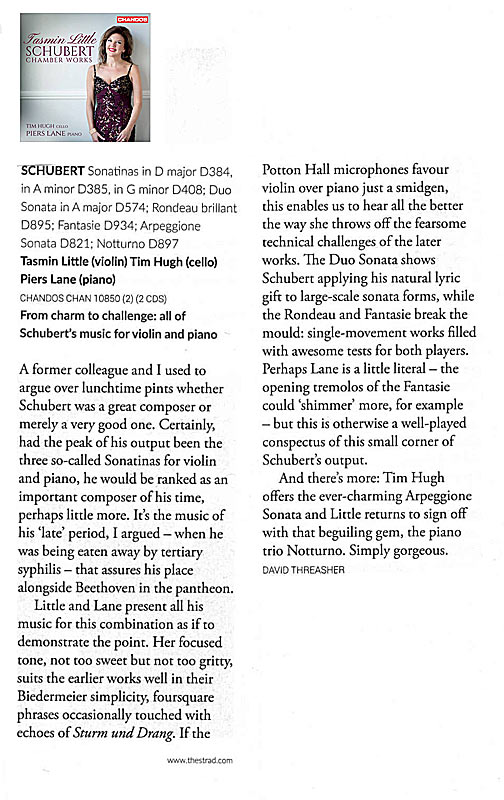
Guillaume Lekeu (1870-1894)
Sonata in G major (1892-93)
Maurice Ravel (1875-1937)
Sonata movement in A minor (1897)
Gabriel Faure (1845-1924)
Sonata No. 1, Op.13 in A major (1875-76)
Tasmin Little violin
Martin Roscoe piano
REVIEWS: |
|---|
New Zealand Herald, Saturday 29th November The slow movement, substantially in 7/4, is a beautifully drawn-out song; as often happens on this disc, you find yourself craning forward to enjoy the very physical sound of bow on string... " |
|---|
International Record Review, November 2014 |
|---|
Gramophone Magazine, December 2014 |
|---|
Strad Magazine, January 2015 Fauré was a man of passionate reserve, a tantalising dichotomy that not only informed his music but also allowed him to appreciate and nurture a wide range of talents at the Paris Conservatoire, including Ravel, whose 1897 sonata movement turns out not to be a stand-alone affair after all but was originally intended to head a multi-movement work. Little and Roscoe sound completely at home in the music’s varied stylistic interfaces, and really come into their own in the chromaticisms of the Lekeu Sonata in a winning performance to rival even that of Yehudi Menuhin (EMI). Exemplary annotations from Roger Nichols and first-rate sound provide the musical icing on the cake." |
|---|
BBC Music Magazine, February 2015 |
|---|
REVIEWS: |
|---|
"Walton’s Violin Concerto is an apt choice of coupling for the Symphony. Begun in 1938 as a result of a commission from Jascha Heifetz, it successfully amalgamates the dazzling virtuoso elements expected by Heifetz with lyrical music that for the first time expresses Walton’s life long love of the Amalfi coast of Southern Italy. This is the second time that Tasmin Little, a true champion of British music, has recorded the Walton Violin Concerto – the first was in the mid 90s with Andrew Litton and the Bournemouth Symphony Orchestra. In Little’s performance, recorded here in the fine acoustic of the Watford Colosseum, it is the lyrical aspects of the first movement and parts of the finale that make the strongest impression. The romantic and dreamy tranquillity of the opening movement is marvellously conveyed by the rapturous sounds that she elicits from her rich toned instrument. The challenges of the central scherzo are met with absolute conviction and mischievous wit, while Gardner and the BBC SO provide incisive accompaniment throughout in which the balance between soloist and orchestra seems ideal. Those seeking a coupling of these two Walton masterpieces will be more than well served by this outstanding disc that certainly warrants a top recommendation. " Graham Williams , Classical CD Choice - May 30th 2014 |
|---|
Rating: **** "To the Violin Concerto, completed in 1939 on a commission from the Lithuanian-born virtuoso Jascha Heifetz, Tasmin Little brings a mellifluous glow and a capricious spirit. This is music of impetuously shifting moods, by turns inward-looking and extrovert, a combination that Little, in close alliance with Gardner and the orchestra, effects with bravura and with a range of tonal shading and a sensitive moulding of phrases that, as in the symphony, lends the music both bloom and sparkle. " GN, Daily Telegraph |
|---|
Rating: **** "The violin concerto, Tasmin Little’s second recording of it, reinforces her position as one of the very top advocates of the work, as she is of British music in general. It is an exceptionally warm and lyrical sound and just as light and agile when it needs to be. The cadenza in the third movement is a masterclass in controlled intensity." Kimon Daltas, Sinfini Music |
|---|
"Little proves that she owns this piece, and constantly engages the listener with singing lines, effortless, wispy figurations, and forthright, athletic playing in the aggressive passages." Marcus Karl Maroney, Concerto.net | The Classical Music Network |
|---|
BBC Music Magazine June 2014 - Recording of the Month - White Hot Walton (Performance ***** Recording *****) "Two masterworks of English music, graced with top-flight interpretations from two exceptional artists and a classy orchestra: what's not to like? The high-octane intensity of Walton's First Symphony is a different proposition from the Violin Concerto, whose alternating roguishness and warmth reflect the southern Italian scene where much of the work was written. This range of demands is superbly met here. Tasmin Little first recorded Walton's Concerto 20 years ago - a reading delivered with an astonishing velocity in the quick passages, and with much soul in the long-breathed lyrical ones. These extremes of pace and mood allow for little in the way of middle ground: Walton here found himself needing to satisfy the ultra-virtuoso requirements of Jascha Heifetz, while also looking to convey in music the happiness of his relationship with Alice, Viscountess Wimborne. The result was a stop-start design that can be difficult to hold together, as Little's earlier disc showed. Her new one squares this near-unsquareable circle remarkably. Little's way with the virtuoso passages is a notch less headlong than before, allowing the ear to savour her phenomenal accuracy, yet with no loss of fire and brilliance. And here expressive range searches out wonderful new regions: the solo violin's first three opening notes here amount to a haunting musical world in themselves, while the Scherzos second tune is graced with a wry, mesmerising wistfulness of tone. Edward Gardner and the BBC Symphony Orchestra provide an accompaniment whose range of detail, by turns brilliant and beautifully precise, is never driven too hard. " Malcolm Hayes - BBC Music Magazine - June 2014 |
|---|
"Long eclipsed by Britten, Walton is a composer in need of champions. His First Symphony and Violin Concerto are supposedly repertoire works, yet we seldom hear them in the concert hall. This CD – a perfect pairing of his two symphonic masterworks – shows what we have been missing. Gardner and the BBC Symphony Orchestra profile the symphony’s turbulent syncopations, brassy dissonances and expressionist brilliance – a truly exhilarating performance. In the concerto, Little finds the nexus between sultry lyricism and rapturous virtuosity." Andrew Clark, Financial Times |
|---|
Like a good wine, violinist Tasmin Little is ageing very well indeed. I have been following her career since the late 1980s, from her crisp, fresh-faced readings of Bruch, Dvorák or Lalo under the late Vernon Handley to her latest Chandos recordings, most notably the best Moeran VC on record. This account of the Walton Violin Concerto is wonderfully fluid, relaxed and eminently musical. Cannot be bettered. I'm not quite so enamored with Edward Gardner's version of Symphony No.1, however. The famous opening chords seem a little too hushed, indistinct. Thankfully, things improve greatly thereafter, and the polish and silvery sound of the BBC SO cannot be denied. A generously filled and crisply recorded album then, highly recommendable for the VC and certainly more than adequate in the symphony. T Muething, The Classical Shop |
|---|
I’d be surprised if Little and Gardner had not studied the recording made by dedicatee and composer – an authoritative but not necessarily compulsory model – but they take all three movements significantly more slowly than those illustrious predecessors. I’m not going to make detailed comparisons, however, because everything on the new Chandos recording sounds just as ‘right’ as on RCA. There are two ways to describe performance that come out on paper looking slower than the opposition: there are those that drag and those that give the music a little more time to breathe. This belongs to the latter type. Chandos had earlier recordings of the First Symphony and the Violin Concerto... but, good as they both are, they are outshone by the new recording .... Of all Tasmin Little’s and Edward Gardner’s recent fine recordings this has impressed me the most. .... I think you’ll want to buy it when you have heard it. Brian Wilson - MusicWeb International |
|---|
"Walton's Violin Concerto is an apt choice of coupling for the Symphony. Begun in 1938 as a result of a commission from Jascha Heifetz, it successfully amalgamates the dazzling virtuoso elements expected by Heifetz with lyrical music that for the first time expresses Walton's life long love of the Amalfi coast of Southern Italy. This is the second time that Tasmin Little, a true champion of British music, has recorded the Walton Violin Concerto – the first was in the mid 90s with Andrew Litton and the Bournemouth Symphony Orchestra. In Little's performance, recorded here in the fine acoustic of the Watford Colosseum, it is the lyrical aspects of the first movement and parts of the finale that make the strongest impression. The romantic and dreamy tranquillity of the opening movement is marvellously conveyed by the rapturous sounds that she elicits from her rich toned instrument. The challenges of the central scherzo are met with absolute conviction and mischievous wit, while Gardner and the BBC SO provide incisive accompaniment throughout in which the balance between soloist and orchestra seems ideal. Those seeking a coupling of these two Walton masterpieces will be more than well served by this outstanding disc that certainly warrants a top recommendation." Graham Williams SA-CD.net |
|---|
Ernest John Moeran (1894-1950) Concerto for Violin and Orchestra (1937-42) Frederick Delius (1862-1934) Legende (c. 1892-95) Gustav Holst (1874-1934 A Song of the Night, Op. 19 No. 1, H 74 (1905) Edward Elgar (1857-1934) Premiere recordings in this arrangement Chanson de matin, Op. 15 No. 2 (1899) Chanson de nuit, Op. 15 No. 1 (1897-99 Salut d'amour, Op. 12 (1888) Ralph Vaughan Williams (1872-1958) The Lark Ascending (1914, revised 1920) Romance for Violin and Orchestra To Marie Hall Tasmin Little violin with the BBC Philharmonic/Sir Andrew Davis |
||||||||||||||||||||
|
||||||||||||||||||||
|
||||||||||||||||||||
|
||||||||||||||||||||
|
||||||||||||||||||||
|
||||||||||||||||||||
| British Violin Sonatas, Volume 1 Howard Ferguson (1908 – 1999) Sonata No. 2, Op. 10 (1946) for Violin and Piano Benjamin Britten (1913 – 1976) Suite, Op. 6(1934 – 35) for Violin and Piano Sir William Walton(1902 – 1983) Sonata (1947 – 49) for Violin and Piano Edited by Hugh Macdonald |
||||||||||||||||||||
|
||||||||||||||||||||
|
||||||||||||||||||||
|
||||||||||||||||||||
Benjamin Britten, Piano and Violin Concerto Benjamin Britten (1913 – 1976) Concerto for Piano and Orchestra, Op. 13 (1938, revised 1945)* Concerto for Violin and Orchestra, Op. 15 (1938 – 39, revised 1950, 1954, and 1965) Tasmin Little violin, Howard Shelley piano BBC Philharmonic / Edward Gardner |
||||||||||||||||||||
REVIEWS: |
|---|
International Record Review: "I have been waiting for some time to hear Tasmin Little in this violin concerto and she does not disappoint. In her own performer's note, she rightly praises the phenomenal account by Ida Haendel, but hers is in no way inferior. Indeed, in some ways, in the inner intensity of her phrasing and outstanding lyrical playing, Little is to be preferred, notably in the astounding decclamato passage in the 'Passacaglia' and in the long Lento e solenne coda, where — like Haendel — she plays the final espressiro passage in octaves (it's not in the score, but the music demands it, without question). Elsewhere, her virtuosity is breathtaking. The playing of the BBC Philharmonic under Gardner is pretty staggering throughout, especially in the second movement (with a virtuoso timpanist), and is superior to the Bournemouth Symphony under Paavo Berglund - good though they are. .... this is a simply magnificent recording which it would be impossible to improve upon." Robert Matthew-Walker |
|---|
Mellor's CD of the Week (Mail on Sunday) "Perhaps the best new recording thus far of Benjamin Britten's centenary year features three fine British artists. Tasmin Little is inspired throughout the Violin Concerto, and Howard Shelley virtuosic in the Piano Concerto, which is often percussive in the manner of Prokofiev. Ed Gardner has long been a Britten specialist, and he and the BBC Philharmonic provide an eloquently idiomatic backcloth. Chandos's recording is also, as ever, first-class. Both are early works, and for me, a cause for regret that Britten was later so pressured by his partner Peter Pears to produce almost entirely vocal music." |
|---|
Witold Lutoslawski Symphony No. 1 (1941-47) Partita (1988) for Violin and Orchestra for Violin and Piano (1984) Tasmin Little violin Chain 2 (1984-85) Dialogue for Violin and Orchestra Tasmin Little, violin Preludia taneczne (1955) (Dance Preludes) for Clarinet Solo, Percussion, Harp, Piano, and Strings Michael Collins, clarinet BBC Symphony Orchestra / Edward Gardner |
REVIEWS: |
|---|
International Record Review (April 2013) "... Any doubt as to Tasmin Little’s identification with this music is quickly banished as she responds with some of her most insightful as well as virtuosic playing on disc. The spacious yet immediate sound is on a par with earlier discs in the series..." Richard Whitehouse |
|---|
The Financial Times (16-17 March 2013) "...Then come Partita and Chain 2, two 1980s violin concertos notable for their expressive intensity, a quality matched by Tasmin Little’s performances ...” Andrew Clark |
|---|
REVIEWS: |
|---|
|
|---|
BBC Music Magazine (January 2013) "Richard Strauss' early Violin Sonata is so full of youthful rhetoric and so obviously pines for the colours of a full orchestra rather than the piano, that it's often a difficult work to bring off convincingly. But Tasmin Little and Piers Lane turn in one of the most satisfying performances I've heard. Their judicious choice of tempos allows the music to breathe naturally. They also display an intense sympathy with Strauss' melodic style, especially in their delicate and atmospheric account of the slow movement. The Strauss is coupled on this recording with a remarkably eloquent interpretation of Respighi s Sonata in B minor. This is also a rather problematic work, in its uneasy mix of Italianate lyricism and Germanic contrapuntal elaboration. Little and Lane's relaxed yet focused reading of the first two movements is balanced by a thrusting, even aggressive account of the passacaglia finale: with its deep piano octaves, this is Respighi at his most Brahmsian. Little's full-toned bravura in this movement reminds us why this Sonata was a favourite of Jascha Heifetz, and Lane has to work just as hard. Performance: ***** Recording: ****" Calum MacDonald |
|---|
REVIEWS: |
|---|
www.classicalsource.com "Tasmin Little has had this soaring work in her repertoire for some time, and the experience shows, especially in those parts well above the stave, which are as secure and well-considered as one could hope for. Coupled with this are spontaneity, so essential in Delius, and an ebb and flow that finds a sympathetic partner in Sir Andrew Davis and the BBC Symphony Orchestra. The cadenza is wonderfully played and paced. Little's earlier recording (now on Decca) with Sir Charles Mackerras is an equally fine performance, but Chandos's more-natural balance has the greater appeal." Peter Joelson |
|---|
GRAMOPHONE (December 2011) "Some two decades ago Tasmin Little set down memorable versions of both the Violin Concerto and Double Concerto with Sir Charles Mackerras at the helm (for Argo and EMI Eminence respectively). Clearly the intervening years have not diminished her abundant love for and entrancing empathy with this glorious repertoire. Not only does she surmount every technical hurdle with ease, her tone remains wonderfully pure and heart-warmingly expressive. Little's partnership with Paul Watkins strikes me as an especial success; indeed, theirs is the most tenderly lyrical and raptly spontaneous performance of the Double Concerto to have yet come my way (and I do not forget the considerable claims of Little's own earlier recording with Raphael Wallfisch). In the Cello Concerto Watkins resuscitates all except two bars of Delius's altogether more challenging original edition of the solo part. Suffice it to say, he brings a wealth of profound musicality, ardour and insight to bear, making his an interpretation to cherish and one to which I can already see myself returning many times. ....The orchestral playing is commendably poised throughout, Chandos's SACD sound airy, rich and glowing. No self-respecting Delian can afford to be without this indispensable issue." Andrew Achenbach |
|---|
The Sunday Times (2 October 2011) “... a magical, sensuous flow is the presiding quality of this superior performance by Little. Watkins is no less captivating in the Cello Concerto, and they are superb together in the Double Concerto, with its heart-easing slow second section.” Paul Driver |
|---|
 |
Ludwig van Beethoven (4 CDs) Piano Concerto No. 1, Op. 15 Piano Concerto No. 4, Op. 58 Rondo, WoO 6 Piano Concerto No. 2, Op. 19) Piano Concerto No. 5, Op. 73 'Emperor' Piano Concerto No. 3, Op. 37 Piano Concerto, Op. 61 Fantasia, Op. 80 Piano Concerto, WoO 4 Triple Concerto, Op. 56 Tasmin Little, violin - Tim Hugh, cello - Orchestra of Opera North, Howard Shelley, pianist |
|---|
REVIEWS: |
|---|
Pianist Magazine - Editor's Choice (February-March 2013) “... what makes this set so unique and appealing is the commitment and freshness Shelley brings to the lesser-known works. Tasmin Little and Tim Hugh are the stars in the Triple Concert, and its good to see that the pianist is not afraid to take himself out of the limelight...” *****" Marius Dawn |
|---|
